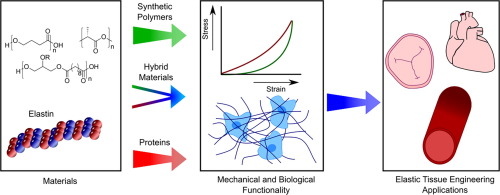Acta Biomaterialia ( IF 9.7 ) Pub Date : 2018-08-28 , DOI: 10.1016/j.actbio.2018.08.027 Anna M.J. Coenen , Katrien V. Bernaerts , Jules A.W. Harings , Stefan Jockenhoevel , Samaneh Ghazanfari

|
Elastin and collagen are the two main components of elastic tissues and provide the tissue with elasticity and mechanical strength, respectively. Whereas collagen is adequately produced in vitro, production of elastin in tissue-engineered constructs is often inadequate when engineering elastic tissues. Therefore, elasticity has to be artificially introduced into tissue-engineered scaffolds. The elasticity of scaffold materials can be attributed to either natural sources, when native elastin or recombinant techniques are used to provide natural polymers, or synthetic sources, when polymers are synthesized. While synthetic elastomers often lack the biocompatibility needed for tissue engineering applications, the production of natural materials in adequate amounts or with proper mechanical strength remains a challenge. However, combining natural and synthetic materials to create hybrid components could overcome these issues. This review explains the synthesis, mechanical properties, and structure of native elastin as well as the theories on how this extracellular matrix component provides elasticity in vivo. Furthermore, current methods, ranging from proteins and synthetic polymers to hybrid structures that are being investigated for providing elasticity to tissue engineering constructs, are comprehensively discussed.
Statement of Significance
Tissue engineered scaffolds are being developed as treatment options for malfunctioning tissues throughout the body. It is essential that the scaffold is a close mimic of the native tissue with regards to both mechanical and biological functionalities. Therefore, the production of elastic scaffolds is of key importance to fabricate tissue engineered scaffolds of the elastic tissues such as heart valves and blood vessels. Combining naturally derived and synthetic materials to reach this goal proves to be an interesting area where a highly tunable material that unites mechanical and biological functionalities can be obtained.
中文翻译:

用于组织工程应用的弹性材料:天然,合成和混合聚合物
弹性蛋白和胶原蛋白是弹性组织的两个主要成分,分别为组织提供弹性和机械强度。胶原蛋白在体外能充分产生,当对弹性组织进行工程设计时,在组织工程设计的结构中弹性蛋白的生产通常不足。因此,必须将弹性人工引入组织工程支架中。当使用天然弹性蛋白或重组技术提供天然聚合物时,可将支架材料的弹性归因于天然来源,而当合成聚合物时,则可归因于合成来源。尽管合成弹性体通常缺乏组织工程应用所需的生物相容性,但是以足够的数量或具有适当的机械强度生产天然材料仍然是一个挑战。但是,将天然和合成材料结合起来以创建混合组件可以克服这些问题。这篇评论解释了合成,机械性能,体内。此外,广泛讨论了目前的方法,从蛋白质和合成聚合物到正在研究的为组织工程构造提供弹性的杂化结构。
重要声明
组织工程化的支架被开发为用于使全身组织发生故障的治疗选择。就机械和生物学功能而言,至关重要的是,支架必须模仿天然组织。因此,弹性支架的生产对于制造诸如心脏瓣膜和血管的弹性组织的组织工程支架至关重要。事实证明,将天然材料和合成材料结合起来可以实现这一目标,这是一个有趣的领域,在这里可以获得将机械和生物学功能结合在一起的高度可调的材料。



























 京公网安备 11010802027423号
京公网安备 11010802027423号